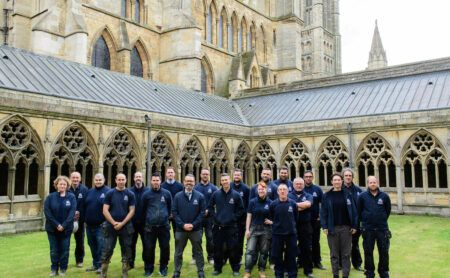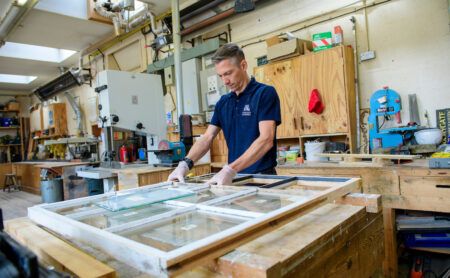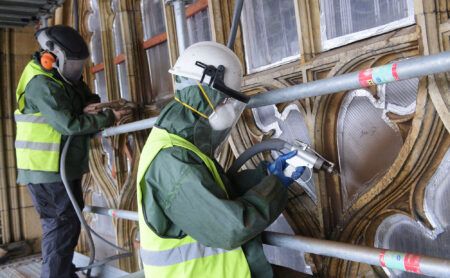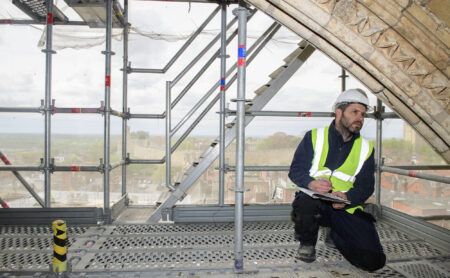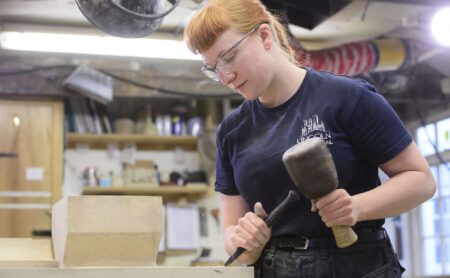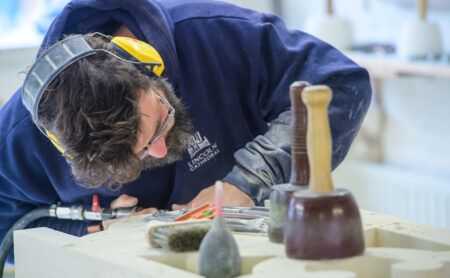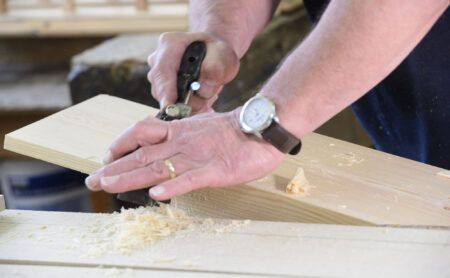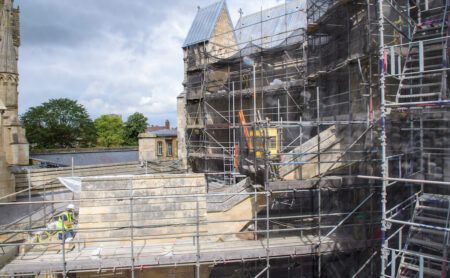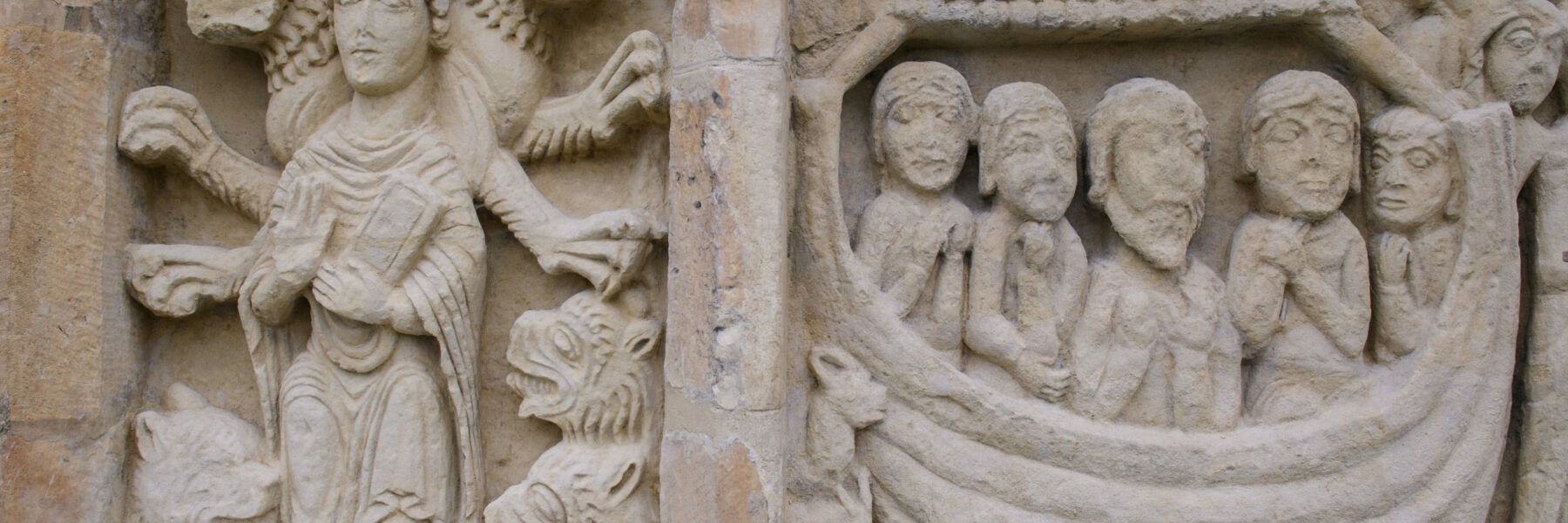
Lincoln Cathedral is one of only a few Cathedrals in England to have its own workforce dedicated to the conservation of the building. There are five craft teams: Stonemasonry and Conservation; Glazing; Carpentry/Joinery; Leadwork; Domus (Engineering and Maintenance).
Find out more about supporting the CathedralWork to build Lincoln Cathedral began in 1072, meaning the oldest parts of the building are now more than 950 years old. It is both a Grade 1 Listed Building and a Scheduled Ancient Monument, meaning it is of outstanding architectural and historic interest and afforded a degree of protection under the law.
Looking after a building of this size, age and importance is a huge task and we are lucky to have a dedicated in-house works team who ensure that it is maintained to survive for generations to come. The work is never ending – there is a 100 year cycle to work around the whole cathedral, at which point it is time to start again! Of course all of this works comes at a cost and the Cathedral does not receive regular government funding; admission to the cathedral and events support some of the costs and our fundraising team work tirelessly to generate income through grants, memberships, donations and legacies.

Stonemasons
The Stonemasonry Team is responsible for the general upkeep of the Cathedral and surrounding properties. Stone is sourced locally to use on the Cathedral and the Close.
Stonemasonry at Lincoln Cathedral
The team restore and repair brick or stone features by taking measurements and templates then reproducing replacements by cutting and carving stones by hand to match the original in the workshop. They are also responsible for other wet trades such as pointing and plastering.
Stone conservation begins with a full survey which produces a detailed document showing all the details of the stone, enabling us to carry out an archaeological survey. This then shows the types of mortar and stone, evidence of decoration, previous repairs, scaffolding evidence and other materials i.e. metals and wood.
Then the hands-on conservation starts, which includes dissolving the black pollution crust, abrasive cleaning and a dry system using compressed air and a finer abrasive powder, which is only used on sculpture. The final stage is to carry out colour-matched mortar repairs and final recording.
Conservators
Lincoln Cathedral has a conservation team who work with the masonry department towards the preservation of the Cathedral’s stonework and sculpture.
The role of the conservator is to preserve as much of the original fabric in-situ as possible. We survey, monitor and create a record of the condition of the Cathedral carvings and monuments before work is carried out and produce detailed records of conservation work undertaken for the works archive.
Conservation at Lincoln Cathedral
Stone conservation begins with a full survey, which produces detailed documents showing all the details of the stone, enabling us to carry out an archaeological survey. This then shows the types of mortar and stone, evidence of decoration, previous repairs, scaffolding evidence and other materials, such as metal and wood.
Then the hands-on conservation starts, which includes dissolving the biological and mechanical pollution using various techniques. Biological pollution includes things such as algae and moss, and mechanical pollution is a black pollution crust.
Cleaning the masonry and sculpture is undertaken using a wide range of techniques, from water washing to lasering in order to remove harmful pollutants and reveal the condition of the stone beneath.
Previous interventions and repairs carried out by predecessors using inappropriate and/or incompatible materials such as Portland Cement and ferrous metals accelerate decay and deterioration of the fabric. These areas need to assessed and where possible remove all incompatible materials and replace with sympathetic materials such as lime mortars, non-ferrous metal dowels, ceramic dowels, lime based grouts and carefully considered adhesives.
The best carvings and examples of stonework which cannot be saved on the building are removed and kept in our sculpture store to aid future understanding of the fabric.
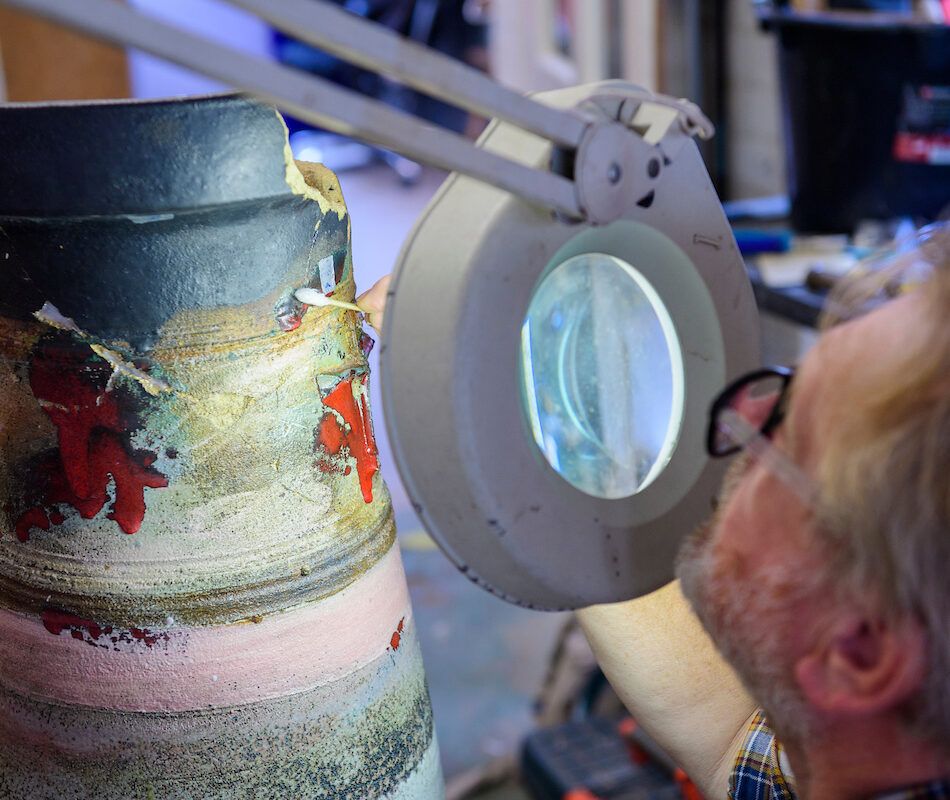
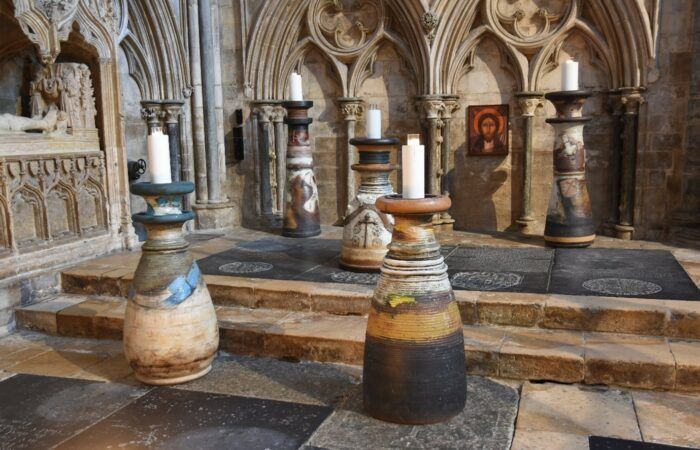
The Gilbert Pots are important pieces for twentieth century art. Following an accident in 2021, one of the pots needed significant repairs. Follow the link to find out more.
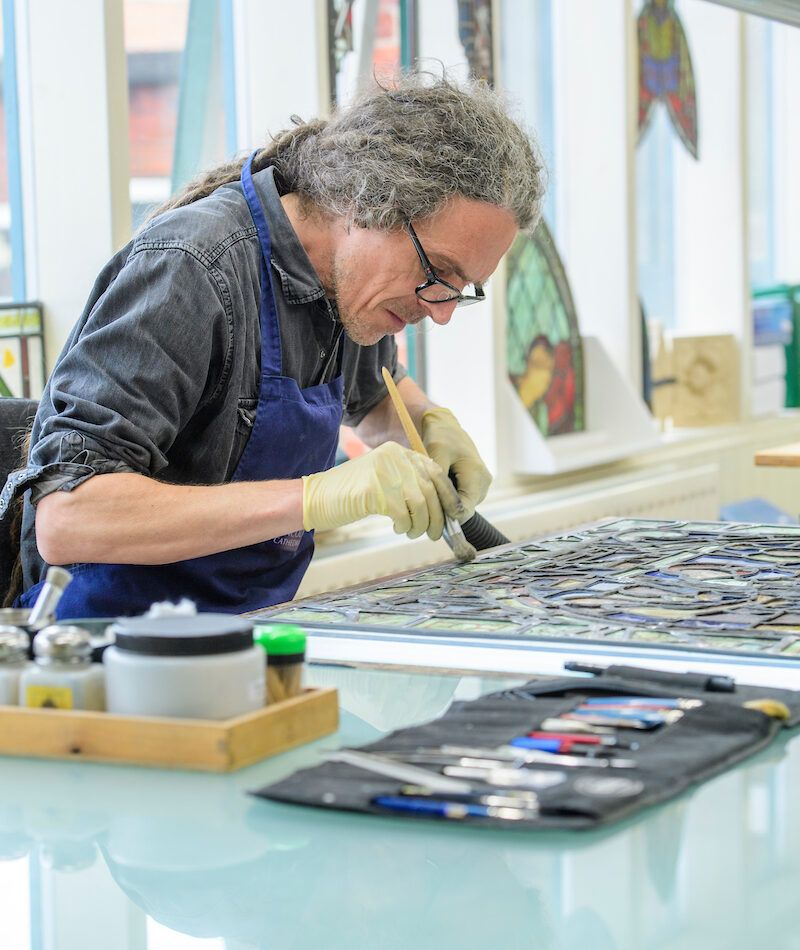
Glaziers
Lincoln Cathedral glazing department is responsible for the conservation and preservation of more than 720 plain and historic stained glass windows within the Cathedral. The department also maintains much of the historic domestic glazing in the close houses which are part of the cathedral estate.
The Cathedral’s glazing includes:
- Internationally important early 13th and 14th century glass, including the north and south rose windows (The Dean’s Eye and Bishop’s Eye)
- 18th century glazing by William Peckitt
- A large arrangement of 19th and 20th century monumental glass.
- Many of the well known Victorian stained glass studios are present, such as Clayton and Bell, Ward and Hughes, and the Hardman Studio.
Stained Glass Conservation at Lincoln Cathedral
Current conservation practices are employed by our small but dedicated team of in-house stained glass conservators to ensure only the most appropriate interventions are carried out. These include; digital diagrammatic mapping, microscopic analysis, chemical edge-bonding and installation of environmental protective glazing.
However the specialist work still relies upon traditional core skills. Cutting glass, leading and glazing, and glass painting are all traditional processes dating back to the medieval period which have changed very little over the centuries.
Joiners
The joinery department is a diverse team that works on the Cathedral and close properties. They work on projects from large complex structural concerns, including the roof of the Cathedral, to repairs on fine antique furniture.
Joinery at Lincoln Cathedral
For the cathedral roof which is in constant need to repair and restoration, the team preserves the wood where possible and repairs or replaces the original wood beams if necessary.
The joinery department carries out all maintenance on estate properties, including work to doors and windows, general maintenance and building bespoke fitted furniture for the houses including shelves and cupboards. They also work closely with other trades in the works department on projects across the Cathedral, for example, preparing centring for the flying buttresses for the masons, and creating oak frames for the stained glass windows for the glaziers.
Some of the tools of the joiners’ trade will be recognisable, such as carving chisels and planes, but some are homemade, adapting more conventional tools for the specialised work required from the team.
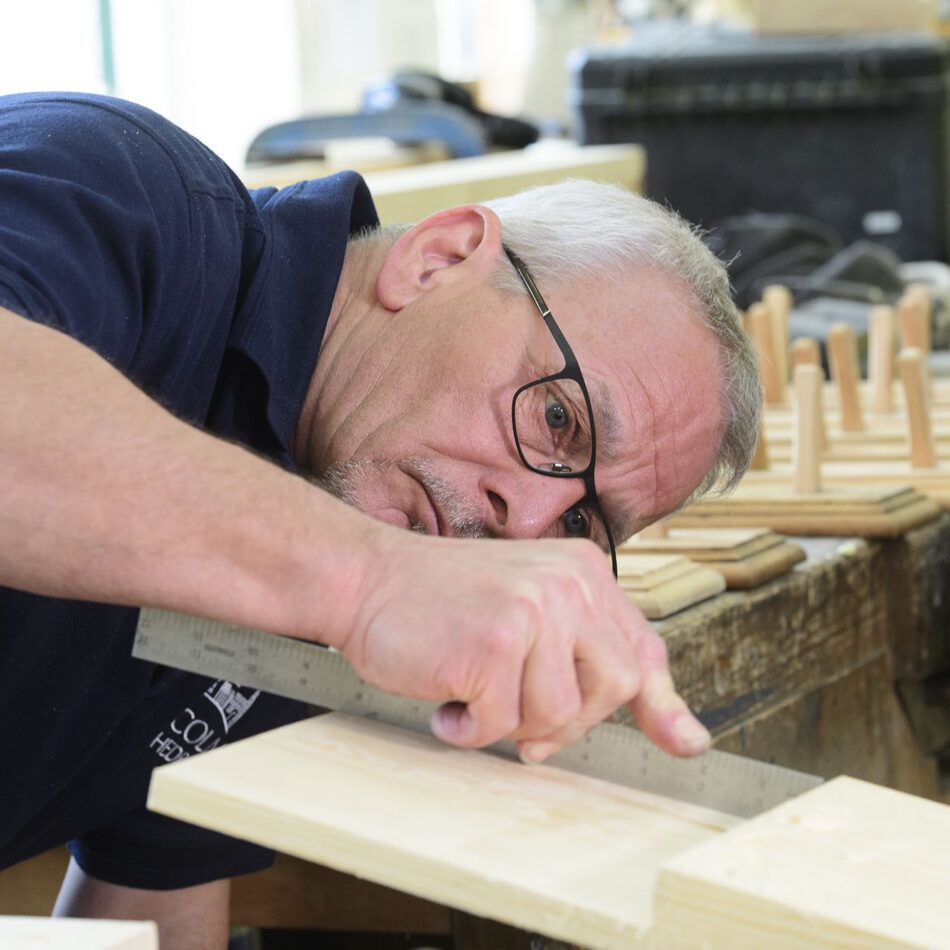

Leadworkers
Our lead worker helps repair and restore the Cathedral roof. The lead is stripped off the roof with a hammer and hacking knife. The old lead is sent away to be recycled by being melted down and made into new lead rolls, which is then returned to the Cathedral ready to be used by the lead working department.
Leadwork at Lincoln Cathedral
Each roll can weigh between 40 and 100kgs. The sheets are unrolled and formed into either gutters or sheets for the roof and dressed by hand using lead dressers, bossing mallets and sticks and chase wedges. The tools are made from boxwood and lignum vitae. New and replacement downpipes and hopper leads are also made by hand.
Oxyacetylene welding equipment is used to weld the joints and roof flashings. The lead workers also look after the rainwater goods on the close properties which is a very important job.
